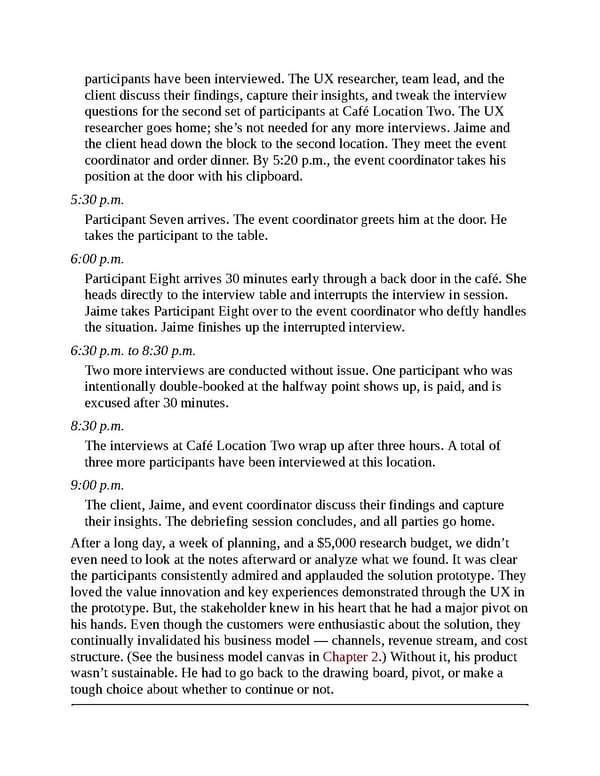participants have been interviewed. The UX researcher, team lead, and the client discuss their findings, capture their insights, and tweak the interview questions for the second set of participants at Café Location Two. The UX researcher goes home; she’s not needed for any more interviews. Jaime and the client head down the block to the second location. They meet the event coordinator and order dinner. By 5:20 p.m., the event coordinator takes his position at the door with his clipboard. 5:30 p.m. Participant Seven arrives. The event coordinator greets him at the door. He takes the participant to the table. 6:00 p.m. Participant Eight arrives 30 minutes early through a back door in the café. She heads directly to the interview table and interrupts the interview in session. Jaime takes Participant Eight over to the event coordinator who deftly handles the situation. Jaime finishes up the interrupted interview. 6:30 p.m. to 8:30 p.m. Two more interviews are conducted without issue. One participant who was intentionally double-booked at the halfway point shows up, is paid, and is excused after 30 minutes. 8:30 p.m. The interviews at Café Location Two wrap up after three hours. A total of three more participants have been interviewed at this location. 9:00 p.m. The client, Jaime, and event coordinator discuss their findings and capture their insights. The debriefing session concludes, and all parties go home. After a long day, a week of planning, and a $5,000 research budget, we didn’t even need to look at the notes afterward or analyze what we found. It was clear the participants consistently admired and applauded the solution prototype. They loved the value innovation and key experiences demonstrated through the UX in the prototype. But, the stakeholder knew in his heart that he had a major pivot on his hands. Even though the customers were enthusiastic about the solution, they continually invalidated his business model — channels, revenue stream, and cost structure. (See the business model canvas in Chapter 2.) Without it, his product wasn’t sustainable. He had to go back to the drawing board, pivot, or make a tough choice about whether to continue or not.
 UX Strategy: How to Devise Innovative Digital Products that People Want Page 215 Page 217
UX Strategy: How to Devise Innovative Digital Products that People Want Page 215 Page 217